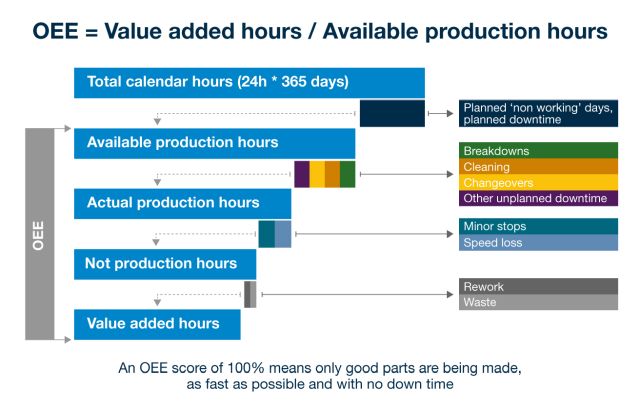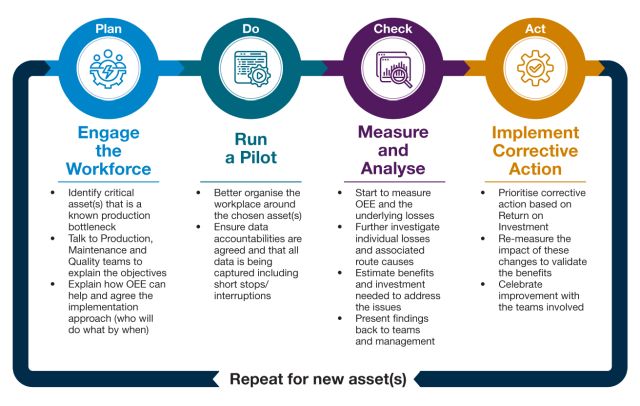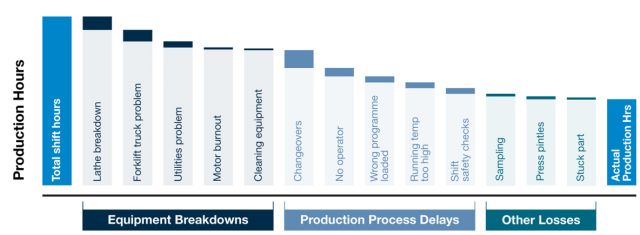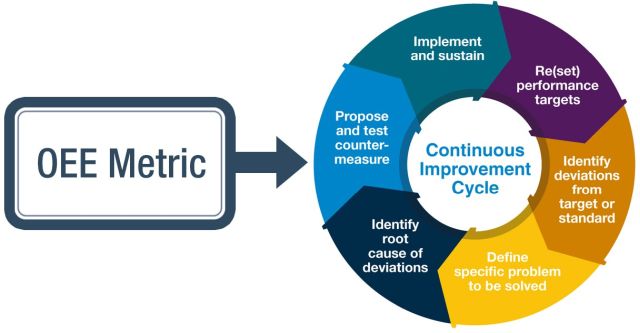"If you don't measure it, you can't improve it."
One of the best ways in which Operations can contribute to the P&L is by transforming shop floor performance to improve productivity. This can result in other benefits, such as improved product quality, customer deliveries on time and less work in progress clogging up those walkways (as well as the balance sheet!).
In our experience, the operational side of a transformation programme often takes a short-term view and is too focused on quick cost out initiatives. True investment in improving performance is frequently overlooked in place of cutting back on direct and indirect costs or reducing inventory for quick cash injections. Such investment need not necessarily mean asset capex, but can often come in the form of investment in people, capability and reliable data.
However, in order to know if performance is actually moving in the right direction, you of course need to measure it. Overall Equipment Effectiveness (OEE) is the 'gold standard' metric for asset intensive manufacturers and producers.
At A&M, we know that it is ultimately people who improve a company's performance, and that true performance transformation can be tough. Our Operations and Supply Chain team works with all stakeholders - from COO to machine operator - to support them through transformation and deliver tangible results quickly. This is the A&M 'muddy boots' approach. Here's what we know works.
Why OEE Matters
Although it's been over 40 years since Seiichi Nakajima described it in his book 'Total Productive Maintenance,' Overall Equipment Effectiveness (OEE) is still poorly understood and misused today.
Simply put, OEE is one of the most useful metrics for measuring asset performance. Whilst the actual metric itself is indicative, by understanding the underlying losses behind it we can start to take the right corrective action to help improve production throughput and quality (relative to the costs associated with these).

In short, OEE helps to
- Measure asset performance
- Understand associated 'losses' i.e. the root cause of underperformance
- Inform what action to take and where
- Improve throughput and quality without having to significantly increase costs
It therefore helps to make links between underperformance and P&L cost.
So what does good look like?
Companies that use OEE will typically have:
- A good appreciation of the importance of measuring performance at all levels of the organisation.
- Recognition of the link between asset performance and overall production efficiency.
- A leadership team that understands the daily issues and problems faced by Production and how OEE can help.
- An OEE champion who can explain the metric to others, identify where it could add the most value and ensure it is deployed consistently.
- Production and Maintenance teams that work closely together.
- Good acceptance of performance measurement and dialogue in Production and Maintenance (aka 'Growth Mindset').
- Recognition that by improving OEE, the business should be able to produce more without having to increase costs (or, depending on the business situation, produce the same at a reduced cost).
How to implement OEE

Here are some of our top tips for making it works
- Focus on people – OEE is most effective as part of a concerted effort to engage with people, help them be more open to the idea of measuring and talking about performance, and collaborate across the organisation to fix real problems.
- The long game – Implementing OEE is a medium- to long-term challenge, and it takes practice to ensure it adds value. Patience and perseverance are needed from the outset by all, but particularly by business sponsors. Focus first on ensuring the right commitment is in place and that everyone has a basic level of understanding of the metric and how it can help.
- Plan in advance – Invest time in ensuring everyone who will be involved in its use is brought in and understands how they might have to change their day-to-day tasks to make it work. Identify the right assets to apply it (e.g. bottlenecks) as part of a pilot and resist the urge to go too big too soon.
- Start small – Ultimately, businesses should aim to apply OEE across many assets to enable comparisons. However, depending on how comparable products and assets actually are, this may be difficult and less meaningful in practice. OEE experts should consider this early as it could help to shape the strategy and implementation approach.
- Means to an end – The percentage OEE figure is only ever indicative – it is the underlying data on losses and detailed understanding of the root causes that are important. Following this, encouraging a culture of continuous improvement will help ensure that the right actions are identified and executed through to completion.
- Articulate the benefits – OEE typically results in time saved, but this needs to be equated to either an increase in available capacity or, depending on the business context, a reduction in direct costs. It may also help to improve product quality by reducing rework time.
OEE in Practice

In this example, a multi-disciplined team collated and categorised loss data over a month for a machine that 'kept breaking down', implying that the machine itself was the main problem. Here, the direct causes of equipment breakdowns clearly need to be investigated.
However, looking at the data we can see that production process delays are having a slightly bigger impact than equipment breakdowns. Most of these tend to be unrelated to the asset itself, and instead related to how people organise around and manage it. Corrective action in such cases may not need a lot of investment, but instead require better training, teamwork and problem solving.
How to take corrective action
- OEE analysis will help to pinpoint where the waste is, but more work is needed to identify the precise root cause and the consequent corrective action.
- Having a strong Continuous Improvement (CI) culture (Kaizen) will help at this point as, invariably, a number of actions will be required. Whilst individually these actions may not be complicated, facing a large number of actions may feel overwhelming for workers when there is so much 'business as usual' to focus on already. This is where support is needed to make sure the right CI 'drumbeat' is in place, and that the right skills are available to help ensure benefits are captured and reported back to the business - whether they are P&L related or otherwise.
- Remember that OEE is a tool to be used as part of a wider management 'system' of performance improvement – it is the follow up actions that are taken from the new insight it can deliver that makes the difference to productivity and hence the P&L.
OEE can therefore be a powerful metric to help improve performance, particularly when used as part of a wider system of continuously seeking ways to reduce waste and improve performance.

The OEE metric should be used as part of a wider continuous improvement approach.
Originally published on 16 February 2024
The content of this article is intended to provide a general guide to the subject matter. Specialist advice should be sought about your specific circumstances.



